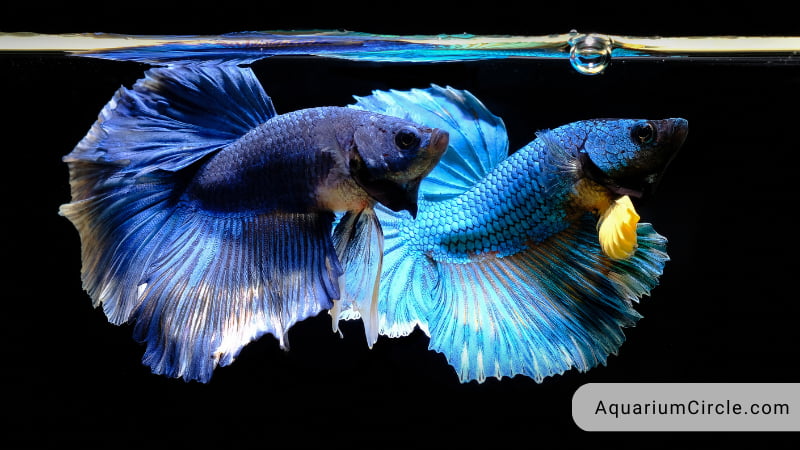Betta fish breeding is an increasingly popular activity among fish enthusiasts, as it allows them to create their own unique strains of betta fish with desirable traits. Betta fish breeding involves the careful selection of breeding pairs, creating an ideal breeding environment, and raising the fry to maturity. It’s a fascinating and rewarding process that requires patience, attention to detail, and a lot of hard work.
In this blog post, we’ll take a closer look at the art of betta fish breeding, from preparing for breeding to raising the fry. Whether you’re a seasoned betta fish keepers or a newcomer to the hobby, this guide will provide you with valuable insights and tips to help you successfully breed your own beautiful and healthy betta fish.
See also:
- Why Betta Fish Staying At Top Of Tank & The Best Solutions For It
- Betta Fish Water Temperature: What Is The Ideal Range Of Betta Fish Water Temp?
- Top 11 Rainbow Female Betta Fish That You Need To Know
How To Distinguish Between Male And Female Betta Fish?
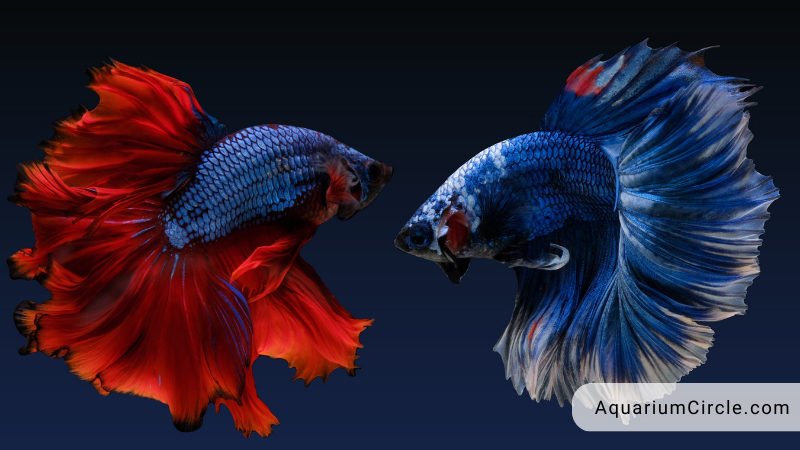
Betta fish, also known as Siamese fighting fish, are popular aquarium fish known for their vibrant colors and flowing fins. If you’re interested in breeding betta fish, it’s important to be able to distinguish between male and female fish. There are several key differences to look for when trying to identify male and female bettas.
Male betta fish tend to have a longer and slimmer body shape, while female betta fish are typically shorter and rounder. Male bettas also have larger, more elaborate fins than female bettas. Their fins are typically longer and more pointed, especially their ventral fins located on the underside of the fish. In contrast, female bettas have shorter and rounder fins.
In many cases, male betta fish are more brightly colored than females. They often have more intense hues of blue, green, red, and purple, while female bettas may have more muted colors. Additionally, male bettas are known for their aggressive behavior, especially towards other males. They may flare their fins and gills when threatened or during courtship displays. Female bettas are generally more docile and peaceful.
Another key difference is the presence of an egg spot, which is a small, white spot on the underside of the female betta. This egg spot is used to attract males during breeding.
By observing these physical and behavioral differences, you can learn to distinguish between male and female betta fish. This knowledge is essential if you want to breed bettas successfully.
When Is The Time Of Betta Fish Breeding Season?
Unlike some fish species that have a specific breeding season, Betta fish can breed throughout the year but they are more likely to breed during the rainy season in their native habitat in Southeast Asia, when the water temperature and level rise, creating ideal conditions for spawning. In captivity, however, breeders can manipulate the breeding conditions to encourage spawning at any time of the year.
How Can We Tell If The Betta Is Ready To Breed?
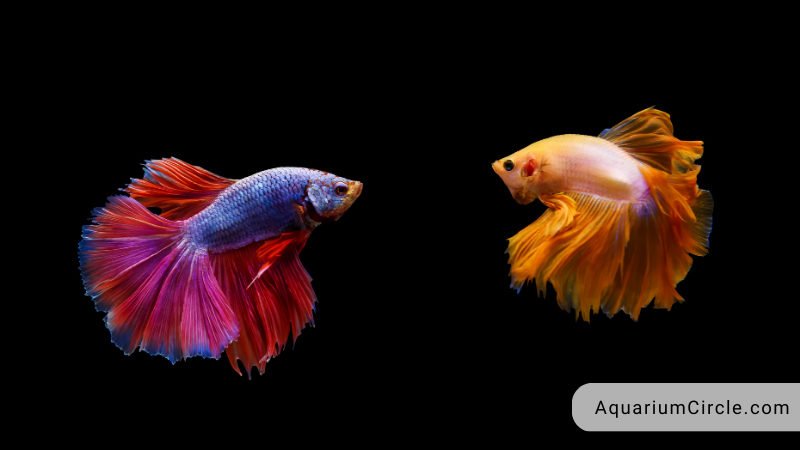
Breeding betta fish can be a rewarding experience, but it’s important to ensure that your fish are ready to start breeding before attempting to do so. The age of your fish is an important factor to consider, as bettas typically reach sexual maturity between 4-6 months of age. In addition to age, the health of your fish is also important, as breeding can be stressful and may cause health problems for sick or weak fish. Check for signs of disease or stress and ensure that your fish are in good health before attempting to breed them.
Physical appearance can also be a good indicator of your betta fish’s readiness to breed. Male bettas will develop elaborate fins and brighter colors as they mature, while females will become rounder in shape. Additionally, male bettas will build a bubble nest on the surface of the water in preparation for breeding. If you notice your male betta building a nest, it’s a good sign that he is ready to mate.
Courtship behavior is another important indicator of your betta fish’s readiness to breed. Male bettas will display courtship behavior, such as flaring their fins and gills and performing a “dance” to attract the female. If you notice your male betta displaying these behaviors, it’s a good indication that he is ready to breed.
Observing these signs and carefully preparing for breeding can increase the chances of a successful breeding attempt and produce healthy and vibrant offspring. However, it’s important to remember that breeding betta fish can be complex, and not all breeding attempts will succeed. As such, it’s important to be patient and prepared for any potential challenges that may arise.
What Is The Ideal Breeding Tank For Betta Fish?
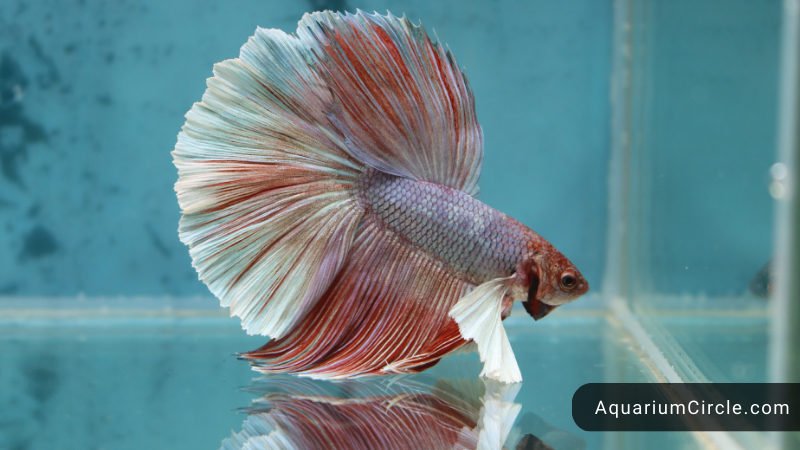
Setting up an ideal breeding tank is crucial for successful betta fish breeding, as the process can be complex. As tropical fish, bettas require warm water temperatures of 78-80°F, which can be maintained with a heater in the breeding tank. The betta breeding tank should be at least 10-20 gallons in size, providing ample space for the breeding pair to swim and for the male to build a bubble nest.
Water quality is also critical, and a filtration system is essential for maintaining good water quality. Regular water changes are necessary to keep the water clean and healthy for the breeding pair. Adding live plants to the fish tank can help maintain water quality and provide hiding places for the fish.
Providing hiding places for the fish is also important in the breeding tank, as bettas like to have plenty of places to retreat. Plants or caves can be added to the tank to provide hiding spots, which can also give the female a place to hide when she needs a break from the male’s courtship behavior.
Lighting is another consideration, as bettas prefer low lighting. It’s important to avoid using bright lights in the breeding tank and use dimmer or natural light to provide enough illumination for the fish without causing stress.
The male betta will build a bubble nest on the top of the tank water surface to prepare for breeding. Providing materials such as floating plants or Styrofoam cups can encourage nest building, and the male will use these materials to create the bubble nest, where the eggs will be deposited during breeding.
Overall, providing an ideal breeding tank can increase the chances of a successful breeding attempt and produce healthy offspring. Monitoring water quality and temperature regularly and being patient with the breeding process is necessary, as it may take some time for the fish to become comfortable in their new environment.
See also: How Many Betta Fish In A 10 Gallon Tank: Useful Guide
How To Pick Up The Successful Breeding Pair?
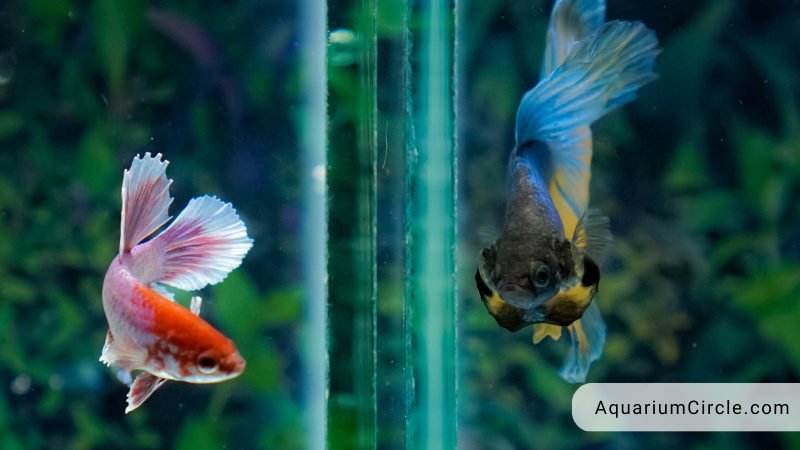
When it comes to the ‘secrets’ of successfully breeding betta fish, choosing the right pair of bettas is essential.
To successfully breed betta fish and achieve your desired outcomes, it is crucial to select the bettas for breeding that is not only healthy but also features the colors and fin shapes you hope to achieve. For instance, if you want to raise veil tail bettas, you’ll need to choose two healthy veil tail fish that possess the desired traits.
It’s highly recommended to purchase your betta fish from a reputable betta breeder as they can provide information about the age of the fish. The perfect breeding time is when both mates are between four months and one year old. Breeding bettas that are over 14 months old is often unsuccessful, and younger fish may not yet have reached their full breeding potential.
When choosing your breeding pair, it’s important to ensure that both fish are in the best possible health. Betta fish with deformities, injuries, or signs of disease, such as white spots or a lethargic nature, should be avoided. By selecting healthy and vibrant fish, you increase the chances of producing healthy offspring and minimizing the risk of genetic abnormalities.
In addition to health and desirable traits, it’s also crucial to consider temperament and compatibility when choosing your breeding pair. Aggressive or overly submissive fish may struggle to coexist, making breeding more challenging. Therefore, it’s important to select fish that are compatible and can coexist peacefully.
See also: Healthy Betta Fish Vs Unhealthy: 9 Signs You Must Notice Before Your Pet Dies
Betta Breeding Process
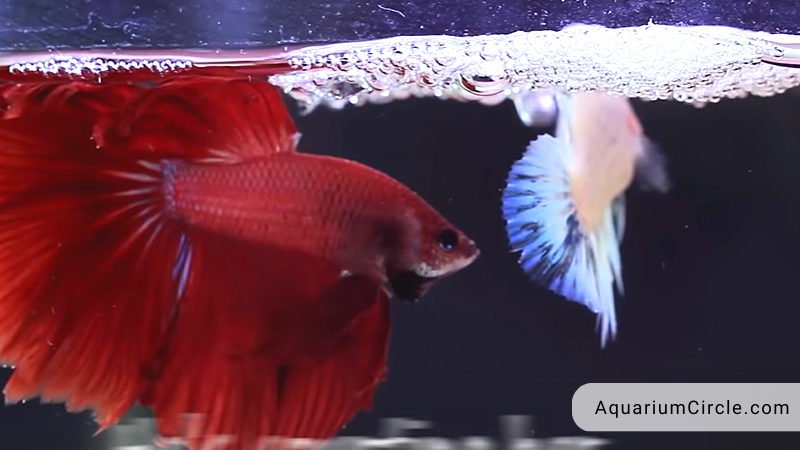
Breeding your betta fish is a complex process that requires a lot of planning and attention to detail. Once you have selected a healthy breeding pair, it’s essential to condition them for breeding. Conditioning involves feeding them a high protein diet, such as live or frozen foods like bloodworms, brine shrimp, and daphnia. This high protein diet helps to build up the energy stores in the fish for the breeding process. During conditioning, it’s also crucial to increase the frequency and amount of food given to encourage the fish to build up their energy stores.
After conditioning, the male and female betta fish are introduced into the breeding tank. The male will begin to court the female by flaring his fins and displaying his vibrant colors. The female may initially show aggression towards the male, but this is normal behavior and should subside as the breeding process continues. Once the male has built a bubble nest on the surface of the water using materials provided in the breeding tank, he will lead the female to it.
During the actual spawning process, the male embraces the female, wrapping his body around hers and releasing sperm to fertilize the eggs as she releases them. The male will collect the betta eggs in his mouth and deposit them in the bubble nest. It’s essential to remove the female from the breeding tank at this point to prevent her from eating the eggs or attacking the male.
After spawning, the male will care for the eggs and newly hatched fry by keeping them in the bubble nest and providing them with oxygen from his gills. It’s important to monitor the water quality during this time, as the eggs and fry are very sensitive to changes in water conditions. After a few days, the fry will begin to swim freely and should be fed with live or powdered fry food.
It’s important to note that the breeding process can be stressful for both the male and female betta fish. It’s crucial to provide them with hiding places and plants around the tank to reduce stress levels. Additionally, it’s essential to provide a stable water temperature and quality to ensure the success of the breeding process.
When should you remove the Female fish?
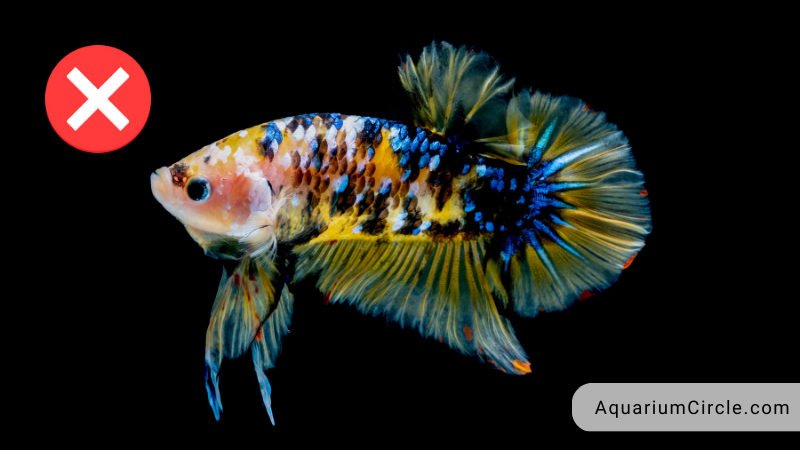
Breeding betta fish involves a delicate process, and one of the most critical steps is to keep the female betta fish out wafter spawning. Unlike other fish species, female betta fish often don’t care for their eggs and may even eat them. This is why it’s essential to remove the female immediately after spawning to ensure the survival of the eggs and fry.
It’s important to handle the female betta fish gently when removing her from the breeding tank. During the mating process, the female may have suffered some injuries, making her more vulnerable to stress and physical harm. Use a soft net or container to scoop her out of the breeding tank and transfer her to a separate tank. Make sure that the tank is clean, and the water conditions are appropriate for the female’s recovery.
When removing the female from the breeding tank, it’s crucial to do it as soon as possible. The longer the female stays in the breeding tank, the greater the risk of her eating the eggs or attacking the male betta fish. This can lead to the loss of the entire clutch of eggs and potentially healthy betta babies.
When should you remove the Male one?
Once the breeding process is complete and the female betta has been removed from the breeding tank, it’s important to leave the male fish in the tank until the eggs hatch and the fry become independent,usually around 2-3 days after spawning. During this time, the male betta will fan the eggs with his fins to circulate the air around them, which helps prevent fungal growth. He may also rearrange the eggs, moving them to different areas of the nest to ensure they receive proper oxygenation.
It’s common for the male betta to be protective of the eggs and fry, chasing after any that swim too far away from the nest. However, once the majority of the fry are swimming independently, it’s best to remove the male betta from the tank. This is because male bettas may eat their own eggs or fry, particularly if they become hungry or stressed. Waiting to feed the betta until it has been returned to its regular tank can help reduce the risk of this happening.
How To Take Care Of Betta Fry?

When you have removed the male betta, it is your obligation to care for the fry.
This is a complicated procedure that will determine how much of your offspring survives, so learn everything you can and ready to keep a close check on these little ones.
Feeding baby Betta fish
When breeding your betta, it’s important to know how to properly care for the fry once they hatch. After 2-3 days of being in the bubble nest, the fry will start to swim around and it’s time to start feeding them.
Betta fry are extremely small and require a different diet than adult bettas. They can only eat live food, such as microworms, vinegar eels, and newly hatched baby brine shrimp. These types of food can be hard to find, but it’s important to create a setup that allows you to grow your own cultures so you have a constant food source. Fry need to be fed 3-4 times a day.
Once the fry reach about a week old, you should start feeding them a diet of mostly baby brine shrimp with a single daily helping of microworms or vinegar eels. At the 2-week mark, they should be switched to eating only baby brine shrimp.
When the fry reach 8-9 weeks old, you can start feeding them live blackworms. You can also introduce them to frozen food at this point, although live food is still the best option.
After another month, you can introduce dry food to the fry, although some bettas may refuse it. It’s important to remember that fry require a specialized diet and care in order to ensure their healthy growth and development.
See also: Why My Betta Fish Won’t Eat? 11 Reasons In Depth That Have Immediate Solutions
Modifying the water
After two weeks of hatching, it is time for the fry’s first water change. However, these fry are still tiny, making it impossible to use a regular siphon without the risk of sucking them up.
While there are specialized systems available for this task, they can be quite costly. Instead, you can use a chopstick and attach it to an air tube. This makeshift siphon can be used just like a regular one.
It is important to start slowly by removing only 1 liter of water at a time. Carefully place the old water in a jar and check it for any fry that may have been accidentally removed.
To add new water, connect an airline tube to a set of air stones and place 2 liters of water in a jug or bucket above the tank. The air stones will ensure a gentle trickle of water that won’t disturb the fry, who are extremely sensitive to even the smallest vibrations.
For the first water change, you will need to replace the removed 1 liter of water with 2 liters of fresh water. However, from the second water change onwards, you should only replace the 1 liter of removed water with 1 liter of fresh water to maintain a good water level and quality.
As the fry grow, you will need to perform daily water changes, removing 1 liter of water and replacing it with fresh water, until the tank reaches its maximum capacity and becomes more suitable for the growing fry.
Taking the Fry out
As the fry approach one month of age, it’s time to transfer them to a larger betta tank to support their continued growth. It’s a good idea to have multiple growing tanks on hand, particularly if you have bettas of varying sizes.
To keep track of which fish are from each breeding, it’s important to keep the fry separated into different tanks for growth. Even if the tanks are smaller in size, it’s essential to ensure that each spawning group has its own tank. However, it’s never recommended to keep a spawn in anything smaller than a 10-gallon aquarium.
Cope with aggression
When betta fry reach the age of 8-9 weeks, they begin to develop their distinctive colors and personalities. At this stage, it is important to monitor them carefully as they become more aggressive towards each other. It is crucial to separate any bullies to ensure that their siblings can thrive and reach their full potential.
To do this, you can use a large storage tub filled halfway with water and place each betta in an empty soda bottle with the top removed. This method allows you to keep them separate without the need for multiple aquariums, saving energy and resources.
Separating the Fry
The timing of when to separate the remaining fry depends on your specific breeding goals. If you are aiming to breed bettas with large, beautiful fins, it’s advisable to separate the males earlier, between 8 to 12 weeks after spawning.
During this phase, male fry and juvenile bettas release hormones that can inhibit the growth of other bettas in the same tank. While this is a natural way of ensuring sufficient territory for survival in the wild, it can negatively impact the growth and development of your entire spawn. Therefore, it’s crucial to monitor their behavior and separate them as needed to ensure the best possible outcome for your breeding goals.
Common Betta Breeding Issues And How to Solve Them
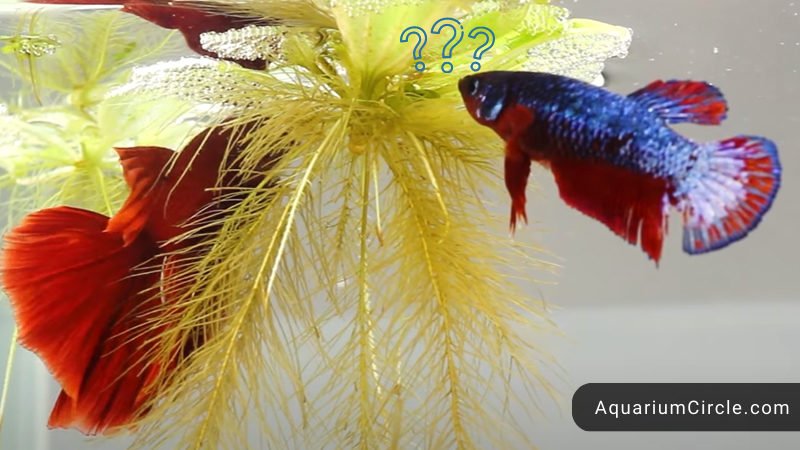
Bettas are exceedingly tough to breed due to their aggressive attitude and complete personalities, and you’re nearly likely to run into troubles of some kind, especially the first time your male betta goes through the spawning process.
Fortunately, most of these issues either go away with time or are reasonably simple to remedy, especially if you carefully monitor every step of the process.
Keep an eye out for these problems
- Reluctant male – While extreme aggression is common in male bettas, some may be reluctant to spawn. To solve this, you can put the reluctant male in a tank with another male to create a sense of competition. Allow them to fight for a few minutes, then remove the one you wish to breed and put him back in the spawning tank. He’ll be more eager to mate.
- Male eating eggs – Unfortunately, this is sometimes unavoidable, especially for first-time spawning males. To prevent this, try not to feed the male until he returns to his regular tank. This may help curb his appetite and prevent him from eating the fry.
- Mold in spawning tanks – Mold often grows in spawning tanks or jars, but you can reduce its occurrence by adding 30 drops or half a tablespoon of Maroxy per 5 gallons of water. This also helps prevent fungus infections caused by young bettas fighting when you’re not around.
- Aggressive breeding pair – Bettas can be selective about their mates, which may lead to aggression. You can reduce the likelihood of aggression by introducing them through a barrier so they can see each other without interacting. If they’re still extremely aggressive, consider using a new breeding pair.
- Dust in fish jars – Dust settles on water just like it settles on your floor, so it can accumulate at the bottom of fish jars and harm the bettas. To prevent this, cover the jars immediately.
- Unhatched eggs – First-time spawning males may not fertilize all their eggs successfully, or at all. If this happens, try again. By the third spawn, the male may be able to fertilize all the eggs.
- Running out of food – A successful mating pair can produce 100-200 fry, making it almost impossible to feed them without growing at least one culture of microworms or vinegar eels. Ideally, grow two or three cultures to ensure there’s enough food.
- Chemical contamination – Air fresheners or glass cleaners used around the aquarium or fish jars may be toxic to the fish. Stick with simple, all-natural cleaning products to avoid chemical contamination.
See also: Top 3 Most Crucial Things To Know Before Getting A Multiple Betta Fish Tank
Expert Tips To Help Breed Betta Fish Successfully
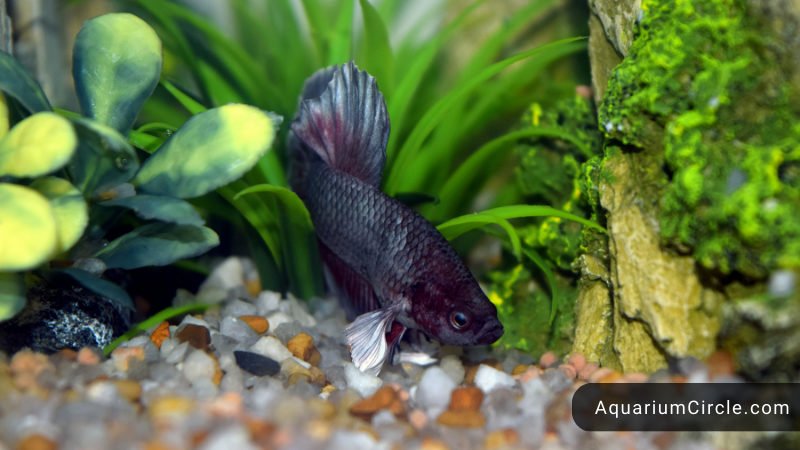
All of the information above should help you avoid severe issues and have a good spawn, but you can do even more to increase the number of fry that develop into beautiful fish by following these expert tips:
Maintain a feeding schedule
By being aware of not just when you feed your fish and fry, but also how much of the food they consume, you can easily determine the appropriate amount of food to add to the tank during each feeding. This helps to prevent excess food from accumulating at the bottom of the tank, which can potentially cause health problems for young fry.
Make a Surface Skimmer
To eliminate the layer of scum and floating debris on the surface of your tank, you can fashion a skimmer by using filter cloth and a coat hanger purchased from a pet store. It may be helpful to include some wire to provide stability for the skimmer.
Gently skim the surface of the water every few days, taking care to avoid accidentally collecting any fry in the process.
Run new water through a filter
While the filter already in your tank will eventually clean the water, it may take some time. Though the dust won’t necessarily harm the fish or fry, it can make it difficult to observe them properly. To address this issue, it’s recommended to attach a cartridge filter to the side of your tank and pour new water through the filter. This will help to speed up the cleaning process and ensure a clearer view of your fish and fry.
Include a Sponge in your Siphon tube
Merely siphoning and replacing water won’t thoroughly clean your tank. To tackle this, trim a small piece of a durable cleaning sponge and affix it to the base of your siphon tube using hot glue. This will create an instrument that can be used to scrub away any residue clinging to the tank’s edges. It’s a gentler way to remove scum without disrupting the fry or fish compared to using a full-sized sponge.
Don’t throw Bettas into the tank right away
When moving bettas into clean water, it’s best to avoid using nets since they tend to accumulate a lot of debris. Instead, gently pick up the betta in your hand and carefully wipe away any dirt before placing them in the new water.
Have at least two sets of jars
Cleaning your fish jars once a week is essential, and having two jars to alternate between can make the process much easier. By rotating the fish between the two jars, you have more time to properly clean each jar without having to handle the fish as frequently, which helps to minimize the risk of causing any stress or harm.
Video About Betta Fish Breeding
FAQs
How do I know when my betta fish is ready to breed?
Males and females are ready to breed when they show their breeding colors and exhibit courtship behaviors such as flaring and nest building.
How long does it take for betta fish eggs to hatch?
Betta fish eggs typically hatch within 24 to 36 hours.
How many babies do breeding betta fish have?
The average spawn of breeding betta fish produces 100-200 fry.
References

Annette M. Chaney is an experienced marine biologist with over 20 years of experience as an aquarist and fishkeeper. She started her first aquarium at a young age, filling it with frogs and goldfish obtained from the ten-cent pet store.
Annette grew up caring for and breeding African Cichlids, which led to a hobby in high school that doubled as a profitable means. Attending Reed College gave her time to solidify herself as an accomplished aquarium caretaker with an eye for sales. After that, from 2009 – 2013, she studied at Roger Williams University – one of the most prestigious universities for Aquaculture and Aquarium in USA. She is the founder of AquariumCircle since 2010.
